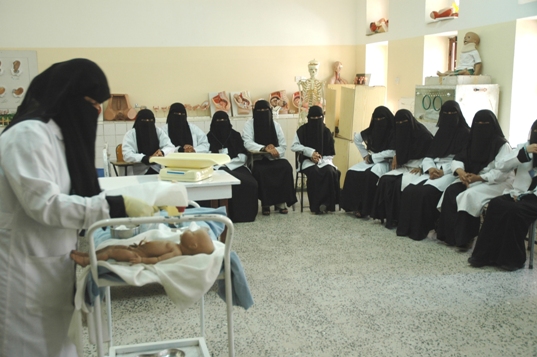Field Stories
Review of SFD support to health institutes (2002–09)

In late 2009 and beginning of 2010, the SFD support to the HIs was evaluated to learn the lessons from this support and to plan more effective ways to enable HIs to contribute to meeting the health needs of the Yemeni population.
The evaluation presented a review of SFD support to HIs between 2002–2009 and recommendations for the future. It was based on evidence collected by interviews, documents and statistical data.
The review found out evidence that, had it not been for the SFD support since 2002, nursing and paramedic training would have decreased in quantity and quality and HIs would have been less able to provide for the health workforce needs of the country. SFD support was fully implemented and had a greater impact than other support. However, the limited impact of SFD support in some areas may be due to lack of integration of HIs strategy with MoPHP strategy, to the underdeveloped HI management capacity, and to weak linkages between HIs and health services at all levels.
Findings of the Health Institutes Support Review
What support was provided?
The main types of SFD support provided were:
- Buildings: five new HIs, classrooms, laboratories and student hostels.
- Furniture, equipment and books.
- Enhancing teaching skills and qualification: courses in teaching methods and paying tuition fees and living costs for teachers to upgrade their diplomas to bachelor degrees and improving course curricula.
- Student financing: 2,700 students from priority areas have received stipend amounting to $100/month.
- Other support: directly financing courses mostly in community midwifery, and supporting HIs to develop the 2006-2010 HI strategy.
What was the impact?
There is a set of clear evidence based on various sources and leading to the below impact:
- This support significantly has led to the increase in the number of graduates, most of whom gained employment in health services and many of them got employment in the poor rural areas. This suggests that without the SFD support, a half of the number of students would have been graduating each year than there are now, and the graduates from the rural areas would have been significantly fewer than they are now.
- The support improved the quality of HI courses, primarily, through improving the curricula of 5 courses. The support improved the teaching skills of many HI teachers and developed their knowledge on the curricula subjects through financing scholarships to upgrade 120 diploma holders to attain bachelor degrees, and through providing with some teaching equipment and aids.
- SFD also directly financed HIs providing training courses for the community midwifes from the poorest areas who would return to their areas and would help to reduce the maternal and child mortality (the 4th and 5th MDGs).
This sort of SFD support was not among the MOPHP, Ministry of Civil Service and Ministry of Finance's priorities, and it came in the time the His became independent from the MoPHP. The SFD prevented the HIs from further deterioration but it helped sustain morale, and it contributed to improve their performance.


Find us here